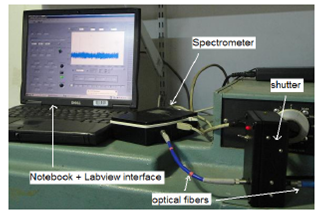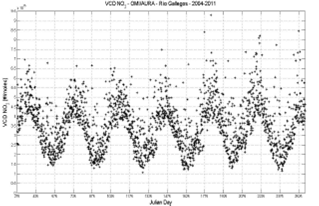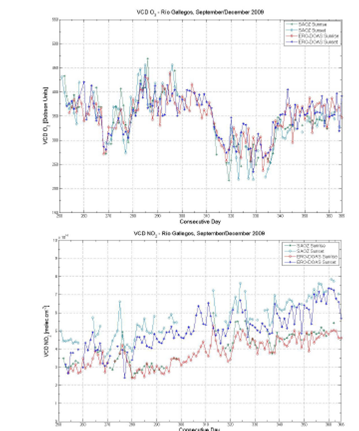Servicios Personalizados
Revista
Articulo
Indicadores
-
 Citado por SciELO
Citado por SciELO -
 Accesos
Accesos
Links relacionados
-
 Similares en
SciELO
Similares en
SciELO
Compartir
Revista Boliviana de Física
versión On-line ISSN 1562-3823
Revista Boliviana de Física v.20 n.20 La Paz 2012
Determination of the seasonal variation of the nitrogen dioxide and ozone vertical column density at Río Gallegos, Santa Cruz province, Argentina, using a zenith-sky DOAS system
Marcelo Raponi, Elian Wolfram, Eduardo Quel
Centro de Investigaciones en Láseres y Aplicaciones, CEILAP (CITEDEF-CONICET), UMI-IFAECI-CNRS 3351 Juan B. de La Salle 4397, B1603ALO, Villa Martelli, Buenos Aires, ARGENTINA
Tel: +541147098100 ext 1410, Fax: +541147098122, E-mail: mraponi@citedef.gob.ar
Rodrigo Jiménez
Grupo de Investigación en Calidad del Aire, Departamento de Ingeniería Química y Ambiental, Universidad Nacional de Colombia
Bogotá, COLOMBIA
Jorge Tocho
Centro de Investigaciones Ópticas, CIOp (CONICET La Plata-CIC) Buenos Aires, ARGENTINA
SUMMARY
Stratospheric ozone (O3) plays a critical role in the atmosphere by absorbing most of the biologically damaging solar UV radiation before it reaches the Earths surface. Nitrogen dioxide (NO2) is a key trace gas in the ozone photochemical. The systematic sensing of NO2 and other minority gases is essential in order to understand the stratospheric O3 destruction and formation processes. We present the study carried out on the seasonal variation of the O3 and NO2 vertical column density (VCD), using a zenith-sky DOAS (Differential Optical Absorption Spectroscopy). This system is composed of a spectral analyzer (portable spectrometer HR4000, Ocean Optics), two optical fibers (400 µm of core, 25 cm and 6 m of longitude) and an automatic mechanical shutter. NO2 and O3 VCD are derived from solar spectra acquired during twilights (87° - 91° zenithal angles). The data retrieved by our instrument are compared with those coming from the SAOZ spectrometer (Systeme d'Analyse par Observation Zenithale, Laboratoire Atmosphères, Milieux, Observations Spatiales (LATMOS), France). Both systems are located in Rio Gallegos, Santa Cruz province, Argentine (51° 36 S; 69° 19 W, 15 m asl), in the CEILAP-RG remote sensing station.
Key words: zenith-sky DOAS, NO2, O3, OMI, SAOZ
INTRODUCTION
Stratospheric ozone (O3) plays a critical role in the atmosphere by absorbing most of the biologically damaging solar UV radiation before it reaches the Earths surface. The most important nitrogen species emitted to the atmosphere are nitrous oxide (N2O), nitrogen oxides (NOx = NO+NO2) and ammonium (NH3). N2O is an important greenhouse gas which is naturally emitted by earth and sea bacteria, and also produced by human activities, mainly agriculture. It is a very stable molecule which is transported to the stratosphere. In the middle and upper stratosphere N2O is converted to NO by reaction with excited oxygen atoms O (1D) produced mainly by UV photolysis of O3 (Fish and Jones, 1995).
During daylight a balance between NO and NO2 concentrations is established through the reaction of the former with O3 and the rapid photolysis and reaction with atomic oxygen of the latter. At night, NO2 is converted first to NO3 and via a three-body reaction to the N2O5 reservoir. This causes a build-up of N2O5 during the night followed by a slow release during the following day through photolysis. The diurnal variation of NO2 therefore comprises a maximum immediately after sunset, followed by a slow decrease throughout the night and a sharp drop to minimum at sunrise.
As well as the diurnal variation there is a seasonal variation in stratospheric NO2 at mid-latitudes due to the combined effects of photochemistry and atmospheric transport (Gil et al., 2007).
The development of remote sensing systems for monitoring of trace gases is fundamental to understand the dynamic processes that occur in the stratosphere. The LIDAR Division (CEILAP-CITEDEF) has in Río Gallegos, Santa Cruz province (51º 36 S; 69º 19 W; 15 m asl) a remote sensing station (CEILAP-RG) where systematically are carry out measurements of several atmospheric parameter (www.division-lidar.com.ar), as for example: the concentration in vertical column O3 and of NO2, the O3 concentration discriminated in height (O3 profile obtained by LIDAR, between 15 and 45 km), aerosol optical thickness, solar irradiance (UV-A, UV-B, NIR), etc. It is necessary to highlight that Río Gallegos city is affected every spring by a significant decrease of the stratospheric O3 that produces an increment of the UV solar radiations that arrive to the surface.
MATERIALS AND METHOD
We present the development of a compact atmospheric remote sensing system, able to determine the VCD (Vertical Column Density) of multiple trace gases. It is a low-cost and portable zenith-sky DOAS system (Figure 1) - hereafter referred to as ERO-DOAS - composed of a mini-spectrometer (HR4000, Ocean Optics), two optical fibers (400 µm of core, 6 m and 25 cm of longitude) and a home-made external shutter (Raponi et al., 2011).

Figure 1. The zenith-sky DOAS systems components: a notebook, the software designed using Labview®, the spectrometer (HR4000), an automatic shutter and the optical fibers.
HR4000 allow us to+ measure solar spectral irradiance in the UV-visible range (290-650 nm). It is a simple spectrograph equipped with a fixed diffraction grating (600 grooves/mm blazed at 400 nm) and a 3648-pixel lineal array CCD. We developed an automatic shutter to determine the dark current of each measurement, and to remove this noise to the twilight spectra. A software development using Labview® controls the start and the end of spectral measurements, the retrieval of acquired spectra and the shutter. The computer internal clock is daily updated to avoid possible time shifts and to maintain accuracy on zenithal and azimuth angles calculations.
The software sets the CCD integration time to maximize signal/noise ratio. The dark (current) spectra are measured with the same integration time than the twilight spectra measured immediately before. This ensures that the subtracted dark noise is similar to the one actually measured over the illuminated period.
The instrumental function and the system resolution were determined using low pressure lamps spectra provided by the Physics Laboratory of Instituto Tecnológico de Buenos Aires (ITBA). We retrieved the spectrometer instrument function from a helium lamp. The full width at half maximum (FWHM) of the Voigt profile fitted to the He line was 1.03 nm at ~447 nm. The lamp spectra were also used to recalibrate EROs wavelength mapping. This recalibration shows a shift of about -1.55 nm from the original (nominal) manufacturer calibration.
The analysis of visible spectra based on the DOAS concept presents the advantage of allowing for simultaneous retrieval of VCDs of different species, over a wide range of meteorological conditions. NO2 and O3 VCDs are retrieved from zenithal solar spectra (in the visible range) acquired on twilight conditions (zenithal angle between 87° and 91°) applying the DOAS (Differential Optical Absorption Spectroscopy) technique.
RESULTS
We present a study on the O3 and NO2 VCDs seasonal variation at Río Gallegos. In Figure 2 we can observe the NO2 VCD seasonal variation at Río Gallegos during 2004-2011, retrieved by OMI/AURA. The concentration ranging from 6x1015 molec/cm2 in summer to 1.6x1015 molec/cm2 in winter and early spring.

Figure 2. NO2 VCD variability at Río Gallegos, Santa Cruz province, Argentina, retrieved by OMI-AURA, from 2004 to 2011.
Figure 3 show the NO2 and O3 vertical column densities obtained with a SAOZ spectrometer (Système d'Analyse par Observation Zenithale), LATMOS (Laboratoire Atmosphères, Milieux, Observations Spatiales), France, located in the CEILAP-RG station, during 2009.

Figure 3: NO2 and O3 VCD seasonal variation during 2009, retrieved by SAOZ spectrometer at Río Gallegos.
In the case of the O3 VCD significant differences are not observed among the concentrations at sunrise and at sunset, as us we waited. In the case of NO2, to be a gas with a comparatively short photochemical time of life, it presents a significant variability during the day. For that reason, an important difference among the concentrations measured during the twilights, exist.
In Figure 4 we compare the O3 and NO2 VCD retrieved by ERO-DOAS and SAOZ spectrometer (both of them located in CEILAP-RG station), during September/December 2009.

Figure 4. O3 and NO2 VCD retrieved by ERO-DOAS and SAOZ instruments at Río Gallegos, during September/December 2009.
For the ozone there is a good agreement among the instruments with an average relative difference about 13%. In the case of NO2, we observe a better agreement among results at sunrise than at sunset between SAOZ and ERO-DOAS data.
CONCLUSIONS
Our zenith-sky DOAS system has the capability of sensing automatically several chemical species and the advantage of being portable (which offers the possibility to move the instrument to carry out measurements campaigns). We observe in both ground-based instruments a strong daily variability of the NO2 VCD (sunrise vs. sunset). This variability is probably associated with the NOx vertical distribution, the temperature in the high layers of the atmosphere and maybe the variability of other active species. In the case of the O3 the daily variability of the gas is low, reason why the comparison between the sunrise and sunset data is very good.
ACKNOWLEDGMENTS
The authors acknowledge to the Japanese International Collaboration Agency (JICA) for funding the acquisition of the HR4000 spectrometer and to SAOZ network and OMI/AURA for the data at Río Gallegos.
REFERENCES
1.- Fish, D., and R. Jones (1995), Rotational Raman scattering and ring effect in zenith sky spectra, Geophys. Res. Lett., 22 (7), 811-14. [ Links ]
2.- Gil, M., M. Yela, L. Gunn, A. Richter, I. Alonso, M. Chipperfield, E. Cuevas, J. Iglesias, M. Navarro, O. Puentedura and S. Rodríguez (2007), NO2 climatology in the northern subtropical region: diurnal, seasonal and interannual variability, Atmos. Chem. Phys. Discuss. 7, 15067-103. [ Links ]
3.- Raponi M., R. Jiménez, E. Wolfram, J. Tocho, E. Quel (2011), Remote sensing of stratospheric NO2 over the Argentinean Antarctica using a DOAS mini-spectrometer, Óptica Pura y Aplicada, 44 (1), 77-82. [ Links ]














